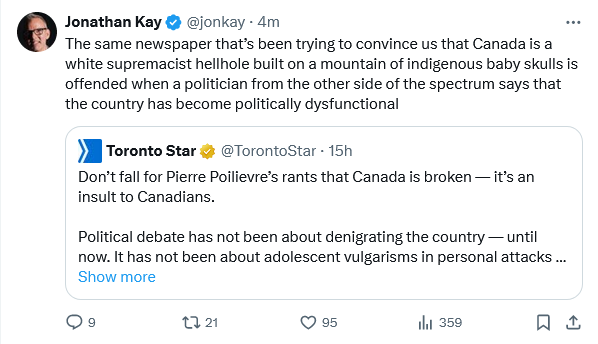The Toronto District School Board has some serious issues if a recent high school “field trip” to a political protest is typical of how the board’s employees are allowed to insert their own political agenda into the teaching process:
There were some parents who opted out of allowing their children to participate in a Toronto District School Board (TDSB) sanctioned field trip to observe (not participate) in a public protest. Parents were informed that the event at Grange Park in Toronto involved the Grassy Narrows First Nation’s decades-long struggle with mercury contamination caused by industry. However, they should have taken this proposed field trip as a major red flag. Indeed, according to Spadina-Fort York MP Kevin Vuong, “What the TDSB teachers did was deceitful and unconscionable”.
When I was a kid, my school never attended a protest. And before last Wednesday, I’ve never heard of any school ever planning such an inappropriate field trip – that ended up being used by the ultra-woke TDSB as an excuse to indoctrinate children into social justice activism (which entails the labelling of all white/Jewish children as racists, colonizers, and settlers on stolen land). How many TDSB parents were even aware of what they were signing up for? It appears that many knew of the general shape of things – which had something to do with Grassy Narrows and mercury poisoning – but no parent could have known about the anti-Israel / anti-Semitic component (a mainstay of social justice), which appeared to be the focal point, eclipsing anything to do with Canadian First Nations.
Indeed, the email from the TDSB explained that the protest event was an “educational opportunity … to learn about Indigenous activism, environmental justice and human rights”. The red flag would have been enormous and flapping vigorously in a strong wind for those parents who are initiated into the tenets of critical social justice theory. To those parents, participation in woke activism is a hard hell no. However, many families are still oblivious, or maybe have misunderstood the intentions of the TDSB, or maybe just don’t quite get what critical social justice is. They are unaware that far too many school administrators, trustees, and teachers have decided that their priority is transforming society through a cultural revolution, not educating the young. This, of course, involves transforming children.
The letter to parents assured them that their children would not be participating in the protest. Students would be on site only to observe. However, videos have emerged on social media of middle school aged children marching alongside anti-Israel protestors. Understandably, many parents now feel betrayed. In my view, they should have seen this coming. The TDSB is literally infested with anti-Semetic black radicals and other such woke activists who follow the same identity politics playbook which entered North America through the period of violent 1960s era black radicalism. (I refer the reader to Cedric Robinson’s volume Black Marxism: The Making of the Black Radical Tradition. And, to Dr. Scott Miller’s essay published in these pages “A Moral Chimera: Diversity, Illiberal No-White-Male Policies and the Power of the Black Radical Tradition“. And lastly, if you want to see black radicals in action, read my piece, “Exploring The Grievance Pathway Of Anti-Racism“, on a Parents of Black Children meeting I attended).
Concerning those videos of the protest which circulated social media sparking outrage amongst parents, according to the Toronto Sun, “footage showed students marching alongside flag-waving Elementary Teachers of Toronto members, while a masked woman in a white ‘Justice for Grassy Narrows’ shirt shouted anti-Israel chants into a megaphone”.
CG Idit Shamir (Consul General @IsraelinToronto) posted the following to X (I completely agree with her sentiment):
“Shocking. 7th and 8th graders from public schools in Toronto were taken yesterday on a Toronto District School Board (TDSB) -approved field trip—not to a museum, but to march in a political protest where they chanted pro-Palestine slogans. Adults in keffiyehs and face coverings led the way, while young minds were subjected to a one-sided political narrative.
“The @tdsb has crossed a line. Children get sent to school to learn; they should NEVER be forced to participate in political protests. It’s not just that they’ve taken a side—it’s that they have utterly disregarded the rights of pro-Israel and Jewish students and staff, along with any commitment to truth and balance. This isn’t education; it’s indoctrination—it’s an affront to the very purpose of education.”
MPP Goldie Ghamari, also had a strong reaction:
“What the actual f**k is going on with @tdsb educators in Toronto?
This isn’t 1944 Nazi occupied Germany.
This is 2024 in Canada.
This antisemitic behaviour is unacceptable.
If you stay silent after reading this, you’re part of the problem and need to hang your head in shame.”














